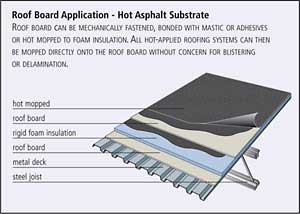Low-Slope Commercial Roofing
Even some cover boards touted as water resistant experienced degradation. The water-resistant cover board materials were not necessarily waterproof, but were being used in hostile environments where the boards were destined to fail. In some cases, the water-resistant board was installed in designs where moisture would clearly be present, such as the reroofing of roofs with wet and even saturated insulation.
These experiences led to formulation changes in core materials and the development of surface coatings to limit moisture-related problems, reduce the quantities of adhesive required to apply membranes and enhance adhesion performance. The cost of cover boards increased as more features were added to improve performance levels.
As often happens in the evolution of a product, manufacturers offer enhancements or add-ons for improved performance. Competition eventually develops from products that combine the add-ons into the basic product, creating a single product that meets a variety of needs. These advancements reduce inventory for the distributor and minimize the potential of using the wrong product in the wrong application.
|
||||||||||||||
Besides wetting issues, some gypsum-based products were known to experience limited moisture release as a result of the application of hot asphalt, especially the Type IV asphalt used in SBS (styrene butadiene styrene) membrane applications.
The core of gypsum-based products is composed of a matrix that chemically binds water within the molecular structure of the gypsum. At elevated temperatures, the chemical process known as calcination releases the chemically bound moisture at the cover board surface. Sufficient water can cause blistering of the base membrane as it is applied directly to the cover board, especially if the base membrane is impermeable.
Newer fiber-reinforced, gypsum-based products have been developed to overcome this problem, and are now compatible with the application of Type IV asphalt, as with the installation of impermeable membrane systems directly over the cover board.
The use of a cover board has evolved from its initial function as a flat surface in a profiled metal deck to serving as an essential system component that enhances the capability of virtually every roof system in resisting wind, hail, fire and foot traffic.
Newer cover boards are being developed that will further extend their use, even in some more hostile environments. Thinner, denser boards have been created to replace older materials that required a greater thickness to provide similar or better performance levels.
Recent trends in cover boards include the creation of more water- and mold-resistant boards that provide excellent adhesion for fully bonded systems. Hot asphalt, solvent- and water-based adhesives all require a strong bond to the cover board surface.










